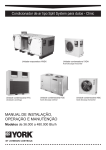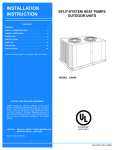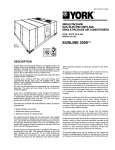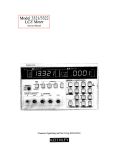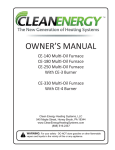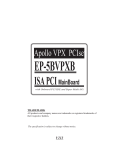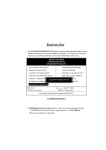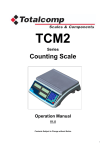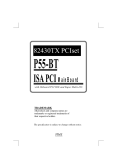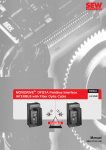Download York H3CE120 Installation manual
Transcript
INSTALLATION INSTRUCTION SPLIT-SYSTEM CONDENSING UNITS AIR COOLED MODELS: H3CE180 & 240 TABLE OF CONTENTS GENERAL . . . . . . . . . . . . . . . . . . . . . . . . . . . . . . . . . . 1 REFERENCE . . . . . . . . . . . . . . . . . . . . . . . . . . . . . . . . 1 LIMITATION . . . . . . . . . . . . . . . . . . . . . . . . . . . . . . . . . 3 LOCATION . . . . . . . . . . . . . . . . . . . . . . . . . . . . . . . . . . 3 O ROOF-TOP LOCATIONS . . . . . . . . . . . . . . . . . . . . . . . 3 O GROUND LEVEL LOCATIONS . . . . . . . . . . . . . . . . . . 3 O RIGGING AND HANDLING . . . . . . . . . . . . . . . . . . . . . 4 POWER AND CONTROL WIRING . . . . . . . . . . . . . . . . 5 CONTROL WIRING . . . . . . . . . . . . . . . . . . . . . . . . 5 COMPRESSOR CRANKCASE HEATER . . . . . . . 5 REFRIGERANT PIPING . . . . . . . . . . . . . . . . . . . . . . . . 8 GENERAL GUIDELINES . . . . . . . . . . . . . . . . . . . 8 GENERAL EXTENDING THE SERVICE PORTS . . . . . . . . . . . . 11 INSTALLATION . . . . . . . . . . . . . . . . . . . . . . . . . . . . . 11 EVACUATION AND CHARGING . . . . . . . . . . . . . . . . 12 STARTUP . . . . . . . . . . . . . . . . . . . . . . . . . . . . . . . . . . 15 PRE-START CHECK . . . . . . . . . . . . . . . . . . . . . . 15 INITIAL STRART-UP . . . . . . . . . . . . . . . . . . . . . . 15 These condensing units are designed for outdoor installation on a roof or at ground level. Every unit is completely piped and wired at the factory and is shipped ready for immediate installation. Only the liquid and suction lines to the evaporator coil, the filter drier, the control wiring and the main power wiring are required to complete the installation. Each unit is dehydrated, evacuated, leak tested and pressure tested at 450 psig before being pressurized with a holding charge of refrigerant-22 for shipment and/or storage. OPERATION . . . . . . . . . . . . . . . . . . . . . . . . . . . . . . . . 15 FIRST STAGE OF COOLING . . . . . . . . . . . . . . . 15 ANTI-SHORT CYCLE TIME DELAY RELAYS . . 15 COMPRESSOR CONTROL MODULE . . . . . . . . 16 LOW OR HIGH PRESSURE LOCK OUT OPERATION . . . . . . . . . . . . . . . . . . . . . . . . . . . . 16 RESETTING THE LOCK OUT . . . . . . . . . . . . . . 16 All controls are located in the front of the unit and are readily accessible for maintenance, adjustment and service. All wiring (power and control) can be made through the front of the unit. REFERENCE This instruction covers the installation and operation of the basic condensing unit. For information on the installation and operation of the evaporator blower units, refer to instruction Form No. 035-16603-000. MAINTENANCE . . . . . . . . . . . . . . . . . . . . . . . . . . . . . 17 All accessories come with a separate Installation Manual. Refer to Parts Manual for complete listing of replacement parts on this equipment. All forms may be ordered from: Standard Register Norman, Oklahoma 73069 Toll Free Tel.: 877-318-9675 Toll Free Fax: 877-379-7920 INSPECTION As soon as a unit is received, it should be inspected for possible damage during transit. If damage is evident, the extent of the damage should be noted on the carrier’s freight bill. A separate request for inspection by the carrier’s agent should be made in wiriting. CAUTION: SAVE THIS MANUAL 035-15470-000 Rev A (1000) 035-15470-000 Rev A (1000) LIST OF FIGURES LIST OF TABLES FIGURE 1 : FIGURE 2 : FIGURE 3 : FIGURE 4 : FIGURE 5 : FIGURE 6 : FIGURE 7 : FIGURE 8 : TABLE 1: UNIT APPLICATION DATA . . . . . . . . . . . . . . . . 3 TABLE 2: PHYSICAL DATA . . . . . . . . . . . . . . . . . . . . . . . . 5 TABLE 3: ELECTRICAL DATA . . . . . . . . . . . . . . . . . . . . . . 6 TABLE 4: SUCTION LINES . . . . . . . . . . . . . . . . . . . . . . . . . 9 TABLE 5: LIQUID LINES . . . . . . . . . . . . . . . . . . . . . . . . . . 10 TABLE 6: REFRIGERANT-22 LINE CHARGE. . . . . . . . . . 10 TABLE 7: CONDENSING UNIT COOLING CAPACITIES . 10 CENTER OF GRAVITY . . . . . . . . . . . . . . . 4 TYPICAL RIGGING . . . . . . . . . . . . . . . . . . 4 TYPICAL FIELD WIRING . . . . . . . . . . . . . . 6 UNIT DIMENSIONS AND CLEARANCES . 7 POINT LOADS. . . . . . . . . . . . . . . . . . . . . . 8 EXTENDING THE SERVICE PORTS . . . . 13 CHARGING CURVE FOR HCE180. . . . . 14 CHARGING CURVE FOR HCE240. . . . . 14 PRODUCT NOMENCLATURE H 3 C E 1 8 0 PRODUCT CATEGORY A 2 5 VOLTAGE CODE H = Split-System Condensing Unit 25 = 208/230-3-60 46 = 460-3-60 58 = 575-3-60 PRODUCT GENERATION 3 = 3rd Generation NOMINAL COOLING CAPACITY 180 = 15 Tons 240 = 20 Tons FACTORY INSTALLED HEAT A = Not Applicable PRODUCT IDENTIFIER CE = Section 2 Unitary Products Group 035-15470-000 Rev A (1000) LIMITATIONS These units must be installed in accordance with all national and local safety codes. If no local codes apply, installation must conform with the appropriate national codes. See Table 1 for Unit Application Data. Units are designed to meet National Safety Code Standards. If components are to be added to unit to meet local codes, they are to be installed at the dealer’s and/or the customer’s expense. TABLE 1: UNIT APPLICATION DATA MODEL Voltage Variation*Min. / Max Ambient Air on Condenser Coil Min. / Max *. 180 & 240 MBH 208/230-3-60 187 / 252 460-3-60 432 / 504 575-3-60 540 / 630 Standard 35°F / 115°F with Head Pressure Control 0°F / 115°F Rated in accordance with ARI Standard 110, utilization range “A”. LOCATION Use the following guidelines to select a suitable location for these units. 1.The condensing unit is designed for outdoor installation only. The condenser fans are the propeller type and are not suitable for use with duct work. 2.The condensing unit and the evaporator blower should be installed as close together as possible and with a minimum number of bends in the refrigerant piping. Refer to “REFRIGERANT PIPING” for additional information. 3.The condensing unit should not be installed where normal operating sounds may be objectionable. On either rooftop or ground level installations, rubber padding can be applied between the base rails and their supports to lessen any transmission of vibration. ROOF-TOP LOCATIONS Be careful not to damage the roof. Consult the building contractor or architect if the roof is bonded. Choose a location with adequate structural strength to support the unit. Unitary Products Group The condensing unit must be mounted on solid level supports. The supports can be channel iron beams or wooden beams treated to reduce deterioration. A minimum of two (2) beams are required to support each unit. The beams should: (1) Be positioned perpendicular to the roof joists. (2) Extend beyond the dimensions of the unit to distribute the load on the roof. (3) Be capable of adequately supporting the entire unit weight. Refer to Figure 1 and Table 2 for load distribution and weights. These beams can usually be set directly on the roof. Flashing is not required. On bonded roofs, check for special installation requirements. GROUND LEVEL LOCATIONS The units must be installed on a one-piece level concrete slab with a minimum thickness of 4 inches. The length and width should be at least 6 inches greater than the units overall base dimensions. Refer to Figure 4. Footers under the slab that extend below the frost line are recommended. Any strain on the refrigerant lines may cause a refrigerant leak. The slab should not be tied to the building foundation because noise and vibration will telegraph into the building. A unit can also be supported by concrete piers. These piers should (1) extend below the frost line, (2) be located under the unit’s four corners, and (3) be sized to carry the entire unit weight. Refer to Figure 1 and Table 2 for the center of gravity and unit weight CARE SHOULD BE TAKEN TO PROTECT THE UNIT FROM TAMPERING AND UNAUTHORIZED PERSONS FROM INJURY.SCREWS ON ACCESS PANELS WILL PREVENT CASUAL TAMPERING. ADDITIONAL SAFETY PRECAUTIONS SUCH AS FENCES AROUND THE UNIT OR LOCKING DEVICES ON THE PANELS MAY BE ADVISABLE. CHECK LOCAL AUTHORITIES FOR SAFETY REGULATIONS. 3 035-15470-000 Rev A (1000) . Unit Rig the unit by attaching chain or cable slings with hooks to the round lifting holes provided in the base rails. Dim. (in.) A B 180 Mbh 16 32 240 Mbh 16 32 SPREADERS, LONGER THAN THE LARGEST DIMENSION ACROSS THE UNIT, MUST BE USED ACROSS THE TOP OF THE UNIT. BEFORE LIFTING A UNIT, MAKE SURE THAT ITS WEIGHT IS DISTRIBUTED EQUALLY ON THE CABLES SO THAT IT WILL LIFT EVENLY. Units may also be moved or lifted with a fork-lift from the front, rear or the compressor end only through the slotted openings provided in the base rails. FIGURE 1 : CENTER OF GRAVITY S P R E A D E R B A R W A R N IN G B e fo r e liftin m a k e s u re is d is tr ib u te th e c a b le s lift e v e n ly . g th e u th a t its d e q u a s o th a t n it, w e ig h t lly o n it w ill LENGTH OF FORKS MUST BE A MINIMUM OF 54” WHEN LIFTING FORM THE COMPRESSOR END OF THE UNIT AND A MINIMUM OF 42” WHEN LIFTING FROM THE FRONT OR REAR OF THE UNIT. Remove the nesting brackets from the four corners on top of the unit. All screws that are removed to take these brackets off must be replaced on the unit. CLEARANCES All units require certain minimum clearances for proper operation and service. Refer to Figure 4 for these clearances. L IF T IN G H O L E S FIGURE 2 : TYPICAL RIGGING DO NOT PERMIT OVERHANGING STRUCTURES OR SHRUBS TO OBSTRUCT CONDENSER AIR DISCHARGE. RIGGING AND HANDLING Exercise care when moving the unit. Do not remove any packaging until the unit is near the place of installation. 4 Additional height may be required for snow clearance if winter operation is expected. Unitary Products Group 035-15470-000 Rev A (1000) POWER AND CONTROL WIRING Install electrical wiring in accordance with the latest National Electrical Code (NFPA Standard No. 70) and/or local regulations. The unit should be grounded in accordance with these codes. POWER WIRING Check the voltage of the power supply against the data on the unit nameplate. Check the size of the power wire, the disconnect switch and the fuses against the data on Table 3. Route the necessary low voltage control wires (18 AWG min.) from the TB1 terminal block inside of the unit control box through this access opening to the room thermostat and to the evaporator blower motor controller. The room thermostat should be located on an inside wall approximately 56" above the floor where it will not be subject to drafts, sun exposure or heat from electrical fixtures or appliances. Follow manufacturer’s instructions enclosed with thermostat for general installation procedure. Refer to Figure 3 for typical field wiring. COMPRESSOR CRANKCASE HEATER NOTE: Copper conductors must be installed between the disconnect switch and the unit. Refer to Figure 4 for the location of the power wire access opening through the front of the unit. This opening will require a field-supplied conduit fitting. The compressor is equipped with a crankcase heater to prevent refrigerant from mixing with crankcase oil during the “OFF” cycle. The heater will be energized when the compressor is not running providing the unit disconnect switch is closed. The field-supplied disconnect switch must be suitable for an outdoor location. Although it should be installed near the unit, do NOT secure it to the unit cabinet. Refer to Figure 3 for typical field wiring. DO NOT ATTEMPT TO START THE COMPRESSOR WITHOUT AT LEAST EIGHT HOURS OF CRANKCASE HEAT OR COMPRESSOR DAMAGE CAN OCCUR. CONTROL WIRING Refer to Figure 4 for the location of the control wire access opening through the front of the unit. TABLE 2: PHYSICAL DATA Condenser Compressor* Model Size (Mbh) Rating (Tons) 24” Fan (Propeller) Unit Weight (lbs.) Coil † Fan Motor Cap. (Stg’s.) Qty. Blades/ Pitch (Deg.) Nom. CFM Qty. HP RPM Rotation Fins per inch Rows Deep Ship. Oper. Charge (Refrigerant-22 lbs.oz.) Holding‡ Oper** 180 15 2 2 3/32 10,800 2 1 1100 CCWLE 20 2 920 930 1-0 24-12 240 20 2 2 3/32 11,300 2 1 1100 CCWLE 20 2 970 990 1-0 32-13 *. Compressor set consists of two Copeland Scroll compressors manifolded into a single refrigerant circuit. †. The ball bearing, 48 frame, single phase condenser fan motor have internal protection that is directly connected to the condenser fans. Motor rotation is counter-clockwise when viewing the lead end, which is opposite the shaft end. ‡. Holding charge is the amount in the unit as shipped from the factory. **. Operating refrigerant charge is for the condensing unit and the matching York air handler, but does not include the charge in the interconnecting piping. See the refrigerant line charge table to determine the additional refrigerant charge required for the interconnecting piping. Unitary Products Group 5 035-15470-000 Rev A (1000) FIGURE 3 : TYPICAL FIELD WIRING H 3 C E 1 8 0 /K 4 E U 1 8 0 3 -P H A S E L IN E V O L T A G E P O W E R S U P P L Y 3 -P H A S E L IN E V O L T A G E P O W E R S U P P L Y D IS C O N N E C T S W IT C H E S A N D F U S IN G B Y F IE L D G R O U N D L U G (F O R G R O U N D W IR E IF R E Q U IR E D ) L 1 L 2 L 3 T B 1 C O N D . S E C T IO N T B 4 R Y 1 X Y 2 B E V A P O R A T O R B L O W E R M O T O R C O N T A C T O R 2 4 V L C O M P R E S S O R 2 4 V L O C K O U T S IG N A L 2 V A M A X . R C Y 2 Y 1 G T H E R M O S T A T 2 T H 0 4 7 0 1 2 2 4 H 3 C E 2 4 0 /L 4 E U 2 4 0 3 -P H A S E L IN E V O L T A G E P O W E R S U P P L Y L IQ U ID S O L E N O ID G R O U N D L U G (F O R G R O U N D W IR E IF R E Q U IR E D ) L 1 L 2 C C O N D . S E C T IO N 1 1 2 T B 4 X L IN E V A L V E S L 3 T B 1 R 3 -P H A S E L IN E V O L T A G E P O W E R S U P P L Y D IS C O N N E C T S W IT C H E S A N D F U S IN G B Y F IE L D Y 1 B 2 Y 2 E V A P O R A T O R B L O W E R M O T O R C O N T A C T O R 2 4 V L C O M P R E S S O R 2 4 V L O C K O U T S IG N A L 2 V A M A X . W IR E IN A C C O R D A N C E W IT H A L L L O C A L A N D N A T IO N A L E L E C T R IC A L C O D E S . R C Y 2 Y 1 G L O W L IN E T H E R M O S T A T 2 T H 0 4 7 0 1 2 2 4 F IE L D V O L T A G E V O L T A G E W IR IN G : C L A S S 2 C L A S S 1 W W N O T E : 2 S O L E N O ID M A Y N O T P R E S E N T O N N E W E R A IR H A N D L E R S . B E IR IN G IR IN G TABLE 3: ELECTRICAL DATA COMPRESSOR* CONDENSER FAN MOTOR MODEL 6 UNIT POWER SUPPLY QTY RLA LRA QTY HP UNIT FLA MINIMUM CIRCUIT AMPACITY (AMPS) MAXIMUM FUSE SIZE† (AMPS) MINIMUM DISCONNECT SIZE‡ (AMPS) HCE180A25 208/230/3/60 2 26.4 189 2 1 5.0 69.4 90 100 HCE180A46 460/3/60 2 13.9 94 2 1 2.6 36.5 50 60 HCE180A58 575/3/60 2 10.1 74 2 1 2.0 26.7 35 30 HCE240A25 208/230/3/60 2 37.4 278 2 1 5.0 94.2 125 100 HCE240A46 460/3/6/60 2 18.4 127 2 1 2.6 46.6 60 60 HCE240A58 575/3/60 2 15.2 100 2 1 2.0 38.6 50 60 Unitary Products Group 035-15470-000 Rev A (1000) *. The 208-230 V compressors and motors use a single tap for the entire range of voltages. The 208/230 V to 24 V transformers have different taps for 208 and 230 V. †. Dual element, time delay type. ‡. Refer to article NEC/NFPA No. 70, articles 440-11,12 for information on minimum disconnect sizing. FIGURE 4 : UNIT DIMENSIONS AND CLEARANCES C O M P R E S S O R A N D F A N M O T O R A C C E S S E X T E R N A L P R E S S U R E G A U G E F IT T IN G S F A N M O T O R A C C E S S A IR O U T A IR O U T F A IR IN F O E E O A F C O N T R O L B O X A C C E S S O 4 4 -9 /3 2 5 -3 /4 C B D 2 4 -1 /2 1 2 -1 /8 3 9 - 7 /8 1 3 -1 /4 3 0 -3 /4 7 -1 /3 2 7 6 -7 /8 9 -1 /3 2 A P P R O X IM A T E C E N T E R O F G R A V IT Y B A C K (C O IL E N D ) 3 2 7 6 - 7 /8 1 6 3 9 - 7 /8 F R O N T CONNECTION ENTRY CONNECTION SIZE 15 Ton 20 Ton Suction Line* A 1/5/8 ID 2-1/8 ID Liquid Line B 5/8 OD 5/8 OD Power Wiring C 2-1/8 KO 2-1/8 KO control Wiring D 7/8 KO 7/8 KO Accessory Wiring E 7/8 KO 7/8 KO Accessory Wiring F 1-3/8KO 1-3/8 KO *. Suction line is a belled fitting NOTE: All dimensions are in inches. They are subject to change without notice. Certified dimensions will be provided upon request. Unitary Products Group Overhead (Top)* 120” Front (Piping and Access Panels 30” Left Side 24” Right Side 24” Rear 24” Bottom† 0” *. Units must be installed outdoors. Overhanging structures or shrubs should not obstruct condenser air discharge. †. Adequate snow clearance must be provided during winter operation. 7 035-15470-000 Rev A (1000) UNIT 4-POINT LOAD (lbs) TOTAL A B C D 180 930 325 218 155 232 240 990 346 232 165 247 * ) + , FIGURE 5 : POINT LOADS REFRIGERANT PIPING GENERAL GUIDELINES Many service problems can be avoided by taking adequate precautions to provide an internally clean and dry system and by using procedures and materials that conform with established standards. Use hard drawn copper tubing where no appreciable amount of bending around pipes or other obstructions is necessary. Use long radius ells wherever possible with one exception— short radius ells for the traps in all suction risers. If soft copper is used, care should be taken to avoid sharp bends which may cause a restriction. Pack fiberglass insulation and a sealing material such as permagum around refrigerant lines where they penetrate a wall to reduce vibrations and to retain some flexibility. Support all refrigerant lines at minimum intervals with suitable hangers, brackets or clamps. Braze all copper to copper joints with Silfos-5 or equivalent brazing material. Do not use soft solder. Insulate all suction lines with a minimum of 1/2" ARMAFLEX or equal. Liquid lines exposed to direct sunlight and/or high temperatures must also be insulated. 8 Never solder suction and liquid lines together. They can be taped together for convenience and support purposes, but they must be completely insulated from each other. A filter-drier MUST be installed in the liquid line of every system to prevent dirt and moisture from damaging the system. A properly-sized filter-drier is shipped with each condensing unit for field installation near the evaporator coil. The filterdrier is shipped inside the unit control box. INSTALLING A FILTER-DRIER DOES NOT ELIMINATE THE NEED FOR THE PROPER EVACUATION OF A SYSTEM BEFORE IT IS CHARGED. A moisture indicating sight-glass may be field installed in liquid line(s) between the filter-drier and the evaporator coil. The moisture indicating sight-glass can be used to check for excess moisture in the system or used as visual means to verify refrigerant charge. Line sizing When sizing refrigerant lines for a split-system air conditioner, check the following: 1. Suction line pressure drop due to friction at full capacity, 2. Liquid line pressure drop due to friction Unitary Products Group 035-15470-000 Rev A (1000) at full capacity, 3. Suction line velocity for oil return at part capacity, and 4. Liquid line pressure drop due to static head. NEVER BASE REFRIGERANT LINE SIZES ON THE OD OF THE SUCTION AND LIQUID CONNECTIONS ON THE UNIT. Tables 4 and 5 list friction losses for both the suction and liquid lines on the system. Table 6 shows the amount of refrigerant charge required per foot of refrigerant line. When the evaporator coil is below the condensing unit, the suction line must be sized for both pressure drop and for oil return. For certain piping arrangements, different suction line sizes may have to be used. The velocity of the suction gas must always be great enough to carry oil back to the compressor. When the condensing unit is below the evaporator coil, the liquid line must be designed for the pressure drop due to both friction loss and vertical rise. If the total pressure drop exceeds 40 psi, some refrigerant may flash before it reaches the thermal expansion valve. This flashing will not only cause erratic valve operation and poor system performance, but could also damage the expansion valve. Service Valves These condensing units have service valves on the compressor suction line and on the liquid line leaving the condenser coil. The liquid and suction line service valves are shipped from the factory front-seated and closed with the valve stem in the maximum clockwise position. The liquid and suction line service valves have a 1/4" male flare access port for evacuating, charging and pressure checking the system. NEVER REMOVE A CAP FROM AN ACCESS PORT UNLESS THE VALVE IS FULLY BACKSEATED WITH ITS VALVE STEM IN THE MAXIMUM COUNTER-CLOCKWISE POSITION BECAUSE THE REFRIGERANT CHARGE WILL BE LOST. ALWAYS USE A REFRIGERATION VALVE WRENCH TO OPEN AND CLOSE THESE SERVICE VALVES. TABLE 4: SUCTION LINES* MODEL DESIGNATION Full Capacity NOMINAL CAPACITY (TONS) REFRIGERANT FLOW RATE 15 45 † (LBS./MIN.) 180 Mbh Part Capacity Full Capacity 8-1/2 20 25.5 60 240 Mbh Part Capacity 10 30 TYPE L COPPER TUBING (INCHES O.D.) REFRIGERANT GAS VELOCITY (FT./MIN.) FRICTION LOSS‡ (PSI/ 100 FT.) 1-5/8 2300 2.5 2-1/8 1360 0.6 1-5/8 1150 0.7 2-1/8 770** 0.2 1-5/8 3120 4.3 2-1/8 1800 1.2 2-1/8 1200 0.4 1-5/8 1560 1.2 2-1/8 900** 0.3 2-5/8 600** 0.1 *. All horizontal suction lines should be pitched at least 1 inch every 20 ft. in the direction of the refrigerant flow to aid the return of oil to the compressor. Every vertical riser greater than 25 ft. in height should have a “P” trap at the bottom to facilitate the return of oil to the compressor. Use short radius fittings for these traps. †. Based on Refrigerant-22 at the nominal capacity of the condensing unit, a suction temperature of 40°F and a liquid temperature of 105°F. ‡. Although suction lines should be sized for a friction loss equivalent to a 2°F change in saturation temperature (or approximately 3 PSI), sizing the lines for the proper return of oil is more important. These friction losses do not include any allowances for valves or fittings. **. Since the refrigerant gas velocity may be too low to maintain good oil return up a vertical riser, use the next smaller size. The larger size may be used for horizontal runs for a smaller pressure drop. Unitary Products Group 9 035-15470-000 Rev A (1000) TABLE 5: LIQUID LINES *. MODEL DESIGNATION NOMINAL CAPACITY (TONS) REFRIGERANT FLOW RATE 180 Mbh 15 45 240 Mbh 20 60 PRESSURE DROP* TYPE L COPPER TUBING (INCHES O.D.) FRICTION (PSI/100 FT.) 3/4 4.7 7/8 2.2 3/4 8.0 7/8 3.5 VERTICAL RISE (PSI/FT.) 0.5 0.5 The total pressure drop of the liquid line for both friction and vertical rise must not exceed 40 PSI. If the pressure drop exceeds 40 PSI, the liquid refrigerant could flash before it reaches the expansion valve. This flashing will only cause erratic valve operation and poor system performance, but could also damage the expansion valve. TABLE 6: REFRIGERANT-22 LINE CHARGE* Liquid Line Inches, O.D.† Suction Line Inches, O.D.† 5/8 0.113 lb./ft. 7/8 0.237 lb./ft. 1-5/8 0.018lb./ft. 2-1/8 0.031 lb./ft. 2-5/8 0.047 lb./ft. *. Charges are based on 40°F suction temperature and a 105°F liquid temperature †. Type “L” copper tubing Note: Add the operating charge of the condensing unit, the evaporator coil and the refrigerant lines to determine the total refrigerant charge of the system. TABLE 7: CONDENSING UNIT COOLING CAPACITIES AND POWER REQUIREMENTS Model 180 240 10 Compressor Suction Pressure (psig) Saturated Temp (°F) 54.9 Ambient Temperature Entering Condenser Coil (°F) 65 75 85 95 105 115 MB* kW† MBH kW MBH kW MBH kW MBH kW MBH kW 30 165 12.3 157 13.4 150 14.8 142 16.3 134 18.1 126 19.9 61.6 35 181 12.5 172 13.6 164 15.0 156 16.5 147 18.3 138 20.2 68.5 40 196 12.7 188 13.9 179 15.3 170 16.7 160 18.6 151 20.4 76.0 45 212 12.9 204 14.1 194 15.5 184 17.0 174 18.9 164 20.8 84.0 50 231 13.2 220 14.3 210 15.8 199 17.3 188 19.1 177 21.0 54.9 30 228 17.3 217 19.2 206 21.1 195 23.4 183 25.9 172 28.5 61.6 35 248 17.7 237 19.6 225 21.5 213 23.8 200 26.4 188 29.0 68.5 40 269 18.1 257 20 244 21.9 231 24.3 218 26.9 204 29.6 76.0 45 291 18.5 277 20.5 264 22.4 250 24.8 236 27.5 222 30.3 84.0 50 313 19.0 299 21 284 23.0 269 25.3 254 28.1 239 30.9 *. Capacities are gross ratings †. Power is for the condensing unit only Unitary Products Group 035-15470-000 Rev A (1000) EXTENDING THE SERVICE PORT 1. Loosen the screws that secure the service ports in shipping position. 2. Push the service ports through the corner post. 3. Tighten the screws to secure the service ports for installation. INSTALLATION Since the condensing units are shipped with a holding charge of Refrigerant-22, they can be checked for a refrigerant leak by depressing the stem on either of the service ports that extend through the cabinet. As soon as some internal pressure is relieved release the stem. DO NOT release the entire holding charge. 5. Carefully clean the internal surfaces of the above. Any particles left on these surfaces may lead to a future system malfunction. NOTE: Use only copper tubing that has been especially cleaned and dehydrated for refrigerant use. If the tubing has been open for an extended period of time, it should be cleaned before being used. The liquid line connections can now be brazed while maintaining a minimum flow of dry nitrogen through the piping as follows: 1. Remove the cap from the 1/4" access port on the liquid line service valve. 2. Connect a supply of dry nitrogen to this access port NOTE: The filter-drier should be installed in the liquid line as close to the evaporator coil as possible. If the unit has already lost its holding charge, it should be leak tested and the necessary repairs should be made. If the unit has maintained its holding charge, you can assume that it has no leaks and proceed with the installation. Do not allow the filter-drier to be exposed to the atmosphere for an extended period of time. Once it absorbs moisture from the atmosphere, it loses its effectiveness. The matched air handlers are shipped with a small R-22 charge and the should be checked for leaks before installation. DRY NITROGEN SHOULD ALWAYS BE SUPPLIED THROUGH A CONNECTION WHILE IT IS BEING BRAZED OR UNBRASED BECAUSE THE TEMPERATURE REQUIRED TO MAKE OR BREAK A BRAZED JOINT IS SUFFICIENTLY HIGH TO CAUSE OXIDATION OF THE COPPER UNLESS AN INERT ATMOSPHERE IS PROVIDED. THE FLOW OF NITROGEN SHOULD BE CONTINUED UNTIL THE JOINT HAS COOLED. When making a braze connection, wrap a wet rag around all tubing inside the unit to help prevent damage to other components. 1. Drill a small hole through the sealing cap or disc in both the liquid and suction connection. If there is a pressure release, the evaporator has no leaks and you can proceed with installation. If the charge has been lost, the coils should be leak tested and the necessary repairs made. 2. Move the dry nitrogen supply from the access port on the liquid line service valve of the condensing unit to the hole through the suction disc on the evaporator coil. 3. Unbraze the coil’s liquid line disc while maintaining a flow of dry nitrogen across the connection and through the hole in the liquid line disc. NOTE: If the liquid line has a solenoid valve, the valve should be opened manually to permit the nitrogen to flow freely. THE DRY NITROGEN SHOULD ALWAYS BE SUPPLIED THROUGH A PRESSURE REGULATING VALVE. 4. Burnish the external surfaces of the liquid connection on the condensing unit and the end of the field-supplied piping for the liquid line. NOTE: Clean surfaces are essential for a wellbrazed connection. Unitary Products Group 4. After the disc has been removed, burnish the external surfaces and clean the internal surfaces as outlined above. 5. Move the dry nitrogen supply back to the access port on the liquid line service valve. 6. Braze the liquid line to the liquid connection on the evaporator coil while maintaining a minimum flow of dry nitrogen through the liquid line, the evaporator coil and the hole in the suction disc. 11 035-15470-000 Rev A (1000) 7. Unbraze the disc on the suction connection of the evaporator coil while maintaining the flow of dry nitrogen. 8. After the disc has been removed, burnish the external surfaces and clean the internal surfaces as outlined above. The suction piping can now be brazed to the suction connection on the evaporator coil while maintaining a minimum flow of dry nitrogen. DO NOT ATTEMPT TO START THE COMPRESSOR WITHOUT AT LEAST 8 HOURS OF CRANKCASE HEAT OR COMPRESSOR DAMAGE WILL OCCUR. Before brazing the suction line to the condensing unit: 1. Move the dry nitrogen supply to the access port on the suction service valve of the condensing unit. 2. Burnish the external surfaces and clean the internal surfaces of both the suction connection and the suction piping. To continue charging refrigerant, open the liquid and the suction line service valves fully. Turn the stem of the liquid service valve clockwise 1/4 turn to open its access port for reading pressure. The suction line can now be brazed to the suction connection on the condensing unit while maintaining the flow of dry nitrogen. Start the compressor (after 8 hours of crankcase heat), turn the stem of the suction line service valve clockwise 1/4 turn to open its service port and continue to charge refrigerant gas through this suction access port until you meet the conditions shown on the charging curve, Fig. 8. After the liquid and suction lines have been installed, the system should be evacuated and charged. Open the liquid and vapor line service valves fully to close their access ports after the system has been charged. EVACUATION AND CHARGING Alternate Charging Methods With the liquid and suction line service valves closed, connect a vacuum pump through a charging manifold to the access ports on both the liquid and suction line service valves. NOTE: The vacuum pump connection should be short and no smaller than 3/8" O.D. The refrigerant lines and the evaporator coil can now be evacuated to 500 microns without disturbing the charge in the condenser coil or the compressor. After proper evacuation and dehydration, charge refrigerant through the access port on the liquid line service valve allowing the vacuum to draw in as much refrigerant as possible. DO NOT CHARGE LIQUID REFRIGERANT THROUGH THE COMPRESSOR SUCTION CONNECTION. 12 If you are starting a unit when the ambient temperature is higher or lower than those shown in Fig. 8, either of the following methods may be used. Method 1: Determine the total weight of the refrigerant for the total system by adding the required charge for the outdoor unit, the indoor unit and the refrigerant lines using information in Tables 2 (Physical Data) and 6 (Refrigerant Line Charge). Using the charging procedures outlined above, weigh the required amount of refrigerant charge into the unit. Method 2: Install a field supplied moisture indicating sight glass in the liquid line between the filter-drier and the evaporator coil. Using the charging procedure outlined above, charge refrigerant until the moisture indicating sight glass is clear. Add approximately 2 extra pounds of refrigerant to assure a liquid refrigerant seal at the expansion valve under all operating conditions. Block the flow of the condenser air, if necessary, to assure a head pressure of 280 psig during the charging procedure. Note: The installer should return to the job to verify the operating charge when the ambient temperature is within the conditions shown in Fig. 8. Unitary Products Group 035-15470-000 Rev A (1000) SERVICE PORTS IN SHIPPING POSITION COPPER UNIT WALL 2 SCREWS COPPER TUBE CORNER POST UNIT WALL SIDE VIEW SERVICE PORTS IN INSTALLED POSITION LOOSEN SCREWS COPPER 2 SCREWS CORNER SIDE VIEW (AS SHIPPED) POST PUSH SERVICE PORTS THROUGH UNIT WALL TOP VIEW CORNER POST TIGHTEN SCREWS ( SERVICE PORTS EXTENDED ) SIDE VIEW ( SERVICE PORTS EXTENDED ) FIGURE 6 : EXTENDING THE SERVICE PORTS Unitary Products Group 13 035-15470-000 Rev A (1000) Charging Curve H*CE180 400 115°F Ambient Discharge Pressure 350 105°F Ambient 300 95°F Ambient 85°F Ambient 250 75°F Ambient 200 57 62 67 72 77 82 87 92 97 87 92 97 Suction Pressure FIGURE 7 : CHARGING CURVE FOR HCE180 Charging Curve H*CE240 400 115°F Ambient Discharge Pressure 350 105°F Ambient 300 95°F Ambient 85°F Ambient 250 75°F Ambient 200 57 62 67 72 77 82 Suction Pressure FIGURE 8 : CHARGING CURVE FOR HCE240 14 Unitary Products Group 035-15470-000 Rev A (1000) STARTUP 2. Move the system switch on the thermostat to the AUTO or COOL position. CRANKCASE HEATER 3. Reduce the setting of the room thermostat to energize the compressor. 4. Check the operation of the evaporator unit per the manufacturer’s recommendations. 5. With an ammeter, check the compressor amps against the unit data plate. 6. Check for refrigerant leaks. 7. Check for any abnormal noises and/or vibrations, and make the necessary adjustments to correct (e.g. fan blade(s) touching shroud, refrigerant lines hitting on sheet metal, etc.) 8. After the unit has been operating for several minutes, shut off the main power supply at the disconnect switch and inspect all factory wiring connections and bolted surfaces for tightness. The crankcase heater must be energized at least 8 hours before starting the compressor. To energize the crankcase heater, the main disconnect switch must be closed. During this 8 hour period, the system switch on the room thermostat must be “OFF” to prevent the compressor from starting.Make DO NOT ATTEMPT TO START THE COMPRESSOR WITHOUT AT LEAST 8 HOURS OF CRANKCASE HEAT OR COMPRESSOR DAMAGE CAN OCCUR sure that the bottom of the compressor is warm to the touch to prove crankcase heater operation. PRE-START CHECK Before starting the unit, complete the following check list: 1. Have sufficient clearances been provided? 2. Has all foreign matter been removed from the interior of the unit (tools, construction or shipping materials, etc.)? 3. Have the condenser fans been rotated manually to check for free rotation? 4. Are all wiring connections tight? 5. Does the available power supply agree with the nameplate data on the unit? 6. Is the control circuit transformer set for the proper voltage? 7. Have the fuses, disconnect switch and power wire been sized properly? 8. Are all compressor hold-down nuts properly secured? 9. Are any refrigerant lines touching each other or any sheet metal surface? Rubbing due to vibration could cause a refrigerant leak. 10. Are there any visible signs of a refrigerant leak, such as oil residue? 11. Is any electrical wire laying against a hot refrigerant line? INITIAL START-UP 1. OPERATION First stage of cooling A call for cooling at terminal Y1 energizes relay RY1. Relay RY1 closes contacts RY1-1, energizing time delay relay 3TR. If time delay relay 3TR is satisfied as described below, it will energize its output terminal Y2, which is connected to compressor 1 control module terminal M1. If the compressor 1 control module is satisfied as described below, it will apply power to terminal 7 of low or high pressure lock out relay (LOR) contacts. See a description of the LOR operation below. If the LOR coil is not energized (not locked out), the LOR contacts will be closed, energizing contactor 1M, which powers compressor 1 and condenser fan motor 1. When 1M is energized on H3CE240 units, auxiliary contact 1M-AC2 is closed, powering terminal 1 for opening the stage 1 solenoid in air handlers which feature a stage 1 solenoid. If the low ambient temperature switch TLA is closed, it will allow condenser fan 2 contactor 3M to energize. TLA opens as the temperature falls below 50 F and closes as the ambient rises above 60 F. TLA is used on the H3CE180, not the H3CE240. Anti-short Cycle Time Delay Relays 3TR and 4TR Relay 3TR, which serves compressor 1 control, has an adjustable low voltage lock out which is set at 20V in the factory. The voltage applied to 3TR must be above its lock out setting and 5 minutes must elapse since the relay was last energized before it will energize its output terminal Y2. Relay 4TR is identical but it serves compressor 2 control. Supply power to the unit through the disconnect switch at least 8 hours prior to starting the compressor. Unitary Products Group 15 035-15470-000 Rev A (1000) Compressor Control Module If the compressor control module terminals L1 (or T1) and L2 (or T2) have 24 V applied and the internal compressor temperature lock out is inactive, the internal switch connecting M1 and M2 will be closed. M1 to M2 will open if one of the compressor’s internal temperature sensors exceeds its limit. M1 to M2 stays open for 30 minutes after a internal temperature limit is exceeded. The 30 minute lock out may be reset prior to the 30 minutes expiring by removing power to the control module terminals L1 and L2. During normal operation, each compressor control module should always be powered at the L1 and L2 terminals, whether there is a call for cooling or not. If the unit does not resume operation after the anti-short cycle timer expires or if it continues to lock out after resuming operation, call a service technician to diagnose and repair the unit. REPEATEDLY RESETTING THE LOCK OUT MAY CAUSE DAMAGE TO THE UNITS Second Stage of Cooling Low or High Pressure Lock Out Operation If the lock out circuit path is opened during a call for cooling, the lock out relay (LOR) coil will energize, opening LOR-1 contacts and disabling all compressor operation. The lock out circuit path is open if: • the lock out relay contacts LOR-1 are open, OR • the low pressure switch LP is open AND the low pressure switch bypass timer contacts 1TR-1 are open, OR • the high pressure switch HP is open Once the LOR coil has been energized, it remains energized, locking out cooling operation until the call for cooling has been removed. When Y1 is returned to 0 volts, the LOR coil is no longer energized, closing the LOR-1 contacts and removing the lock out. The low pressure bypass timer 1TR leaves the 1TR-1 contacts closed upon the start of a call for cooling until its 90 second (nominal) timer has expired. This bypasses the low pressure switch during start up. After the time delay has elapsed, 1TR-1 contacts are opened, once again allowing low pressure to trigger the lock out circuit if the low pressure switch opens. The second stage of cooling will only be enabled if the first stage of cooling is on, closing auxiliary contact 1M-AC1. A call for cooling at terminal Y2 energizes Relay RY2, closing contact RY2-1, and energizing time delay relay 4TR if contact 1M-AC1 is closed. If time delay relay 4TR is satisfied, it will energize its output terminal Y2, which is connected to compressor 2 control module terminal M1. If the compressor 2 control module is satisfied, it will energize time delay relay TDR. After 4 seconds, TDR energizes compressor 2 contactor 2M. When 2M is energized on H3CE240 units, auxiliary contact 2M-AC1 is closed, powering terminal 2 for opening the stage 2 solenoid in air handlers which feature a Stage 2 solenoid. Low Ambient Cooling The following accessories are available to provide low ambient operation to 0°F: 2LA04704225 208/230 VOLTS 2LA04704346 460 VOLTS 2LA04704458 575 VOLTS SAFETY FEATURES 1. The compressor is protected against over current and excessive temperature as described in the Sequence of Operation. During a lock out, the LOR-2 contacts are closed, energizing the X terminal on the terminal board for lighting a lock out warning light. 2. The compressor is equipped with a crankcase heater to discourage refrigerant migration into the compressor sump during the “OFF” cycle. Resetting the Lock Out 3. The condenser fan motors have auto-reset internal protection. 4. The secondary of every transformer is grounded. 5. Every unit is protected by high and low-pressure controls. The lock out may be reset by: •Turning the thermostat switch to OFF, or • Momentarily adjusting the cooling set point to its maximum allowed value. 16 Unitary Products Group 035-15470-000 Rev A (1000) DO NOT ATTEMPT TO START THE COMPRESSOR WITHOUt AT LEAST EIGHT HOURS OF CRANKCASE HEAT OR COMPRESSOR DAMAGE WILL OCCUR. SECURE OWNER’S APPROVAL When the system is functioning properly, secure the owner’s approval. Show him the location of all disconnect switches and thermostat. Teach him how to start and stop the unit and how to adjust temperature settings within the limitations of the system. MAINTENANCE CLEANING CONDENSER SURFACE Dirt should not be allowed to accumulate on the condenser coils or other parts in the condenser air circuit. Clean as often as necessary with a brush, vacuum cleaner attachment or other suitable means. LUBRICATION The fan motors for these condensing units are equipped with factory lubricated and sealed ball bearings. They do not require any maintenance. COMPRESSOR REPLACEMENT Contact the local UPG Distribution Center for compressor or parts. Unitary Products Group 17 035-15470-000 Rev A (1000) NOTES: 18 Unitary Products Group 035-15470-000 Rev A (1000) Unitary Products Group 19 Subject to change without notice. Printed in U.S.A. Copyright © by Unitary Products Group 2000. All rights reserved. Unitary Product Group 035-15470-000 Rev A (1000) Supersedes: 550.23-N6Y 5005 York Drive Norman OK 73069




















